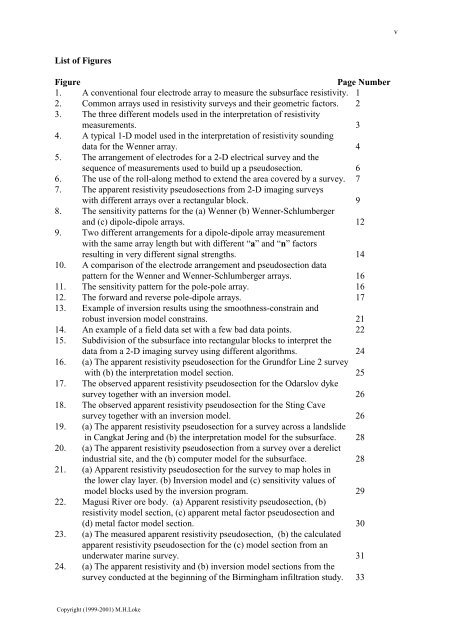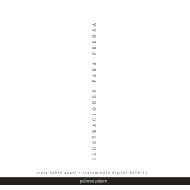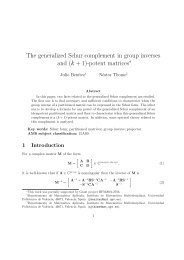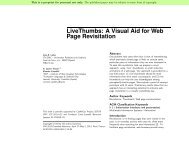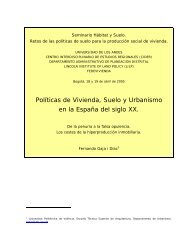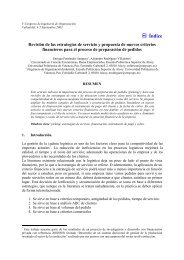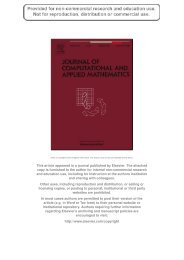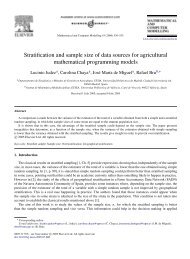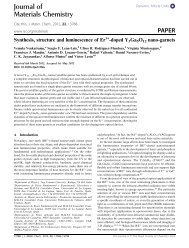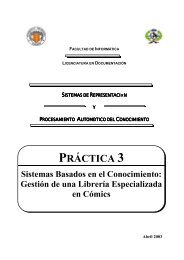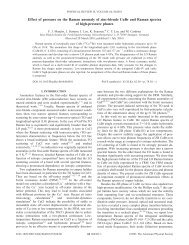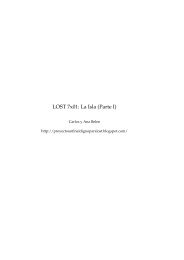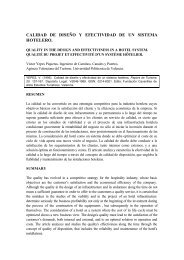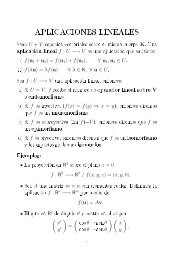Introduction to the resistivity surveying method. The resistivity of ...
Introduction to the resistivity surveying method. The resistivity of ...
Introduction to the resistivity surveying method. The resistivity of ...
You also want an ePaper? Increase the reach of your titles
YUMPU automatically turns print PDFs into web optimized ePapers that Google loves.
v<br />
List <strong>of</strong> Figures<br />
Figure<br />
Page Number<br />
1. A conventional four electrode array <strong>to</strong> measure <strong>the</strong> subsurface <strong>resistivity</strong>. 1<br />
2. Common arrays used in <strong>resistivity</strong> surveys and <strong>the</strong>ir geometric fac<strong>to</strong>rs. 2<br />
3. <strong>The</strong> three different models used in <strong>the</strong> interpretation <strong>of</strong> <strong>resistivity</strong><br />
measurements. 3<br />
4. A typical 1-D model used in <strong>the</strong> interpretation <strong>of</strong> <strong>resistivity</strong> sounding<br />
data for <strong>the</strong> Wenner array. 4<br />
5. <strong>The</strong> arrangement <strong>of</strong> electrodes for a 2-D electrical survey and <strong>the</strong><br />
sequence <strong>of</strong> measurements used <strong>to</strong> build up a pseudosection. 6<br />
6. <strong>The</strong> use <strong>of</strong> <strong>the</strong> roll-along <strong>method</strong> <strong>to</strong> extend <strong>the</strong> area covered by a survey. 7<br />
7. <strong>The</strong> apparent <strong>resistivity</strong> pseudosections from 2-D imaging surveys<br />
with different arrays over a rectangular block. 9<br />
8. <strong>The</strong> sensitivity patterns for <strong>the</strong> (a) Wenner (b) Wenner-Schlumberger<br />
and (c) dipole-dipole arrays. 12<br />
9. Two different arrangements for a dipole-dipole array measurement<br />
with <strong>the</strong> same array length but with different “a” and “n” fac<strong>to</strong>rs<br />
resulting in very different signal strengths. 14<br />
10. A comparison <strong>of</strong> <strong>the</strong> electrode arrangement and pseudosection data<br />
pattern for <strong>the</strong> Wenner and Wenner-Schlumberger arrays. 16<br />
11. <strong>The</strong> sensitivity pattern for <strong>the</strong> pole-pole array. 16<br />
12. <strong>The</strong> forward and reverse pole-dipole arrays. 17<br />
13. Example <strong>of</strong> inversion results using <strong>the</strong> smoothness-constrain and<br />
robust inversion model constrains. 21<br />
14. An example <strong>of</strong> a field data set with a few bad data points. 22<br />
15. Subdivision <strong>of</strong> <strong>the</strong> subsurface in<strong>to</strong> rectangular blocks <strong>to</strong> interpret <strong>the</strong><br />
data from a 2-D imaging survey using different algorithms. 24<br />
16. (a) <strong>The</strong> apparent <strong>resistivity</strong> pseudosection for <strong>the</strong> Grundfor Line 2 survey<br />
with (b) <strong>the</strong> interpretation model section. 25<br />
17. <strong>The</strong> observed apparent <strong>resistivity</strong> pseudosection for <strong>the</strong> Odarslov dyke<br />
survey <strong>to</strong>ge<strong>the</strong>r with an inversion model. 26<br />
18. <strong>The</strong> observed apparent <strong>resistivity</strong> pseudosection for <strong>the</strong> Sting Cave<br />
survey <strong>to</strong>ge<strong>the</strong>r with an inversion model. 26<br />
19. (a) <strong>The</strong> apparent <strong>resistivity</strong> pseudosection for a survey across a landslide<br />
in Cangkat Jering and (b) <strong>the</strong> interpretation model for <strong>the</strong> subsurface. 28<br />
20. (a) <strong>The</strong> apparent <strong>resistivity</strong> pseudosection from a survey over a derelict<br />
industrial site, and <strong>the</strong> (b) computer model for <strong>the</strong> subsurface. 28<br />
21. (a) Apparent <strong>resistivity</strong> pseudosection for <strong>the</strong> survey <strong>to</strong> map holes in<br />
<strong>the</strong> lower clay layer. (b) Inversion model and (c) sensitivity values <strong>of</strong><br />
model blocks used by <strong>the</strong> inversion program. 29<br />
22. Magusi River ore body. (a) Apparent <strong>resistivity</strong> pseudosection, (b)<br />
<strong>resistivity</strong> model section, (c) apparent metal fac<strong>to</strong>r pseudosection and<br />
(d) metal fac<strong>to</strong>r model section. 30<br />
23. (a) <strong>The</strong> measured apparent <strong>resistivity</strong> pseudosection, (b) <strong>the</strong> calculated<br />
apparent <strong>resistivity</strong> pseudosection for <strong>the</strong> (c) model section from an<br />
underwater marine survey. 31<br />
24. (a) <strong>The</strong> apparent <strong>resistivity</strong> and (b) inversion model sections from <strong>the</strong><br />
survey conducted at <strong>the</strong> beginning <strong>of</strong> <strong>the</strong> Birmingham infiltration study. 33<br />
Copyright (1999-2001) M.H.Loke


